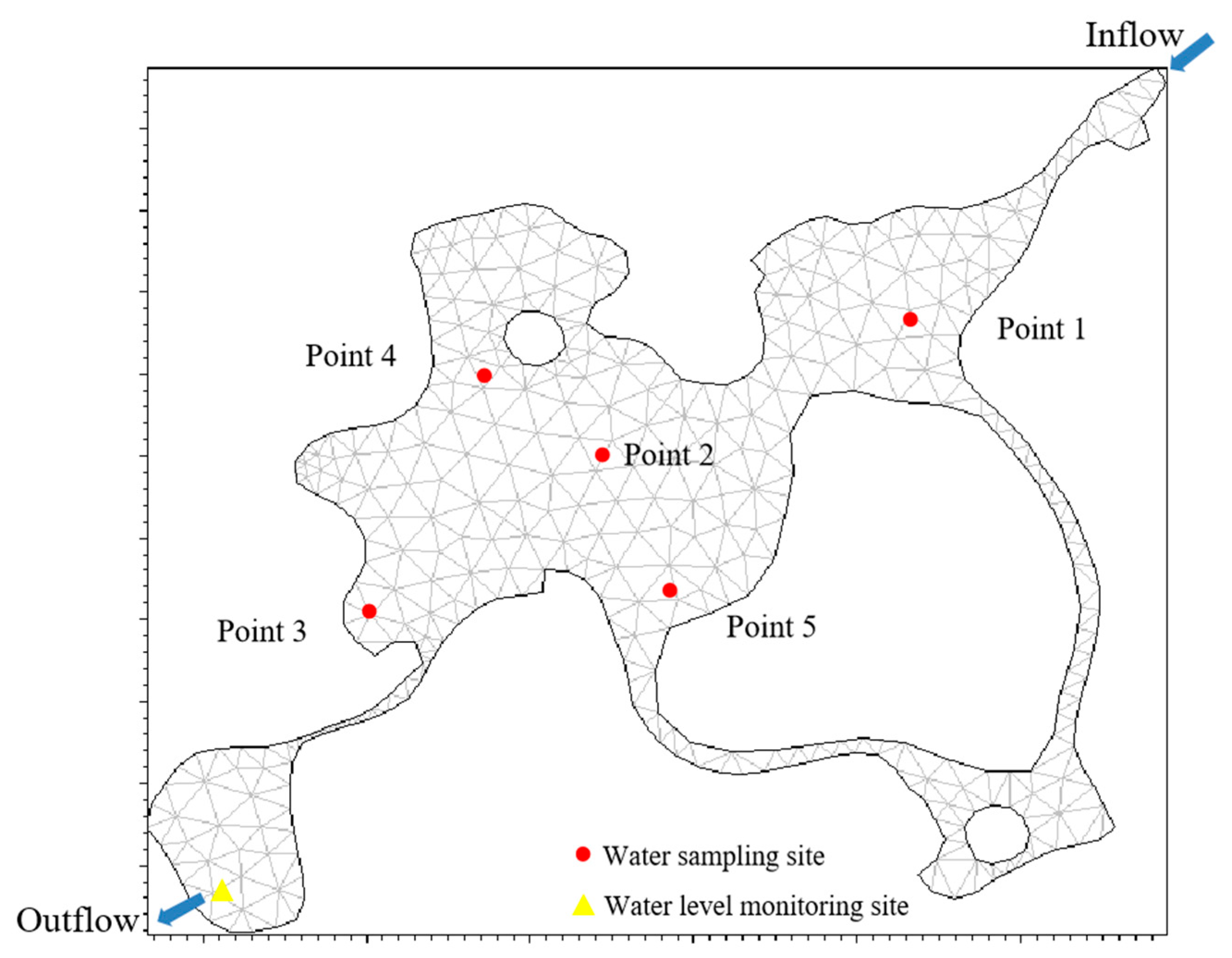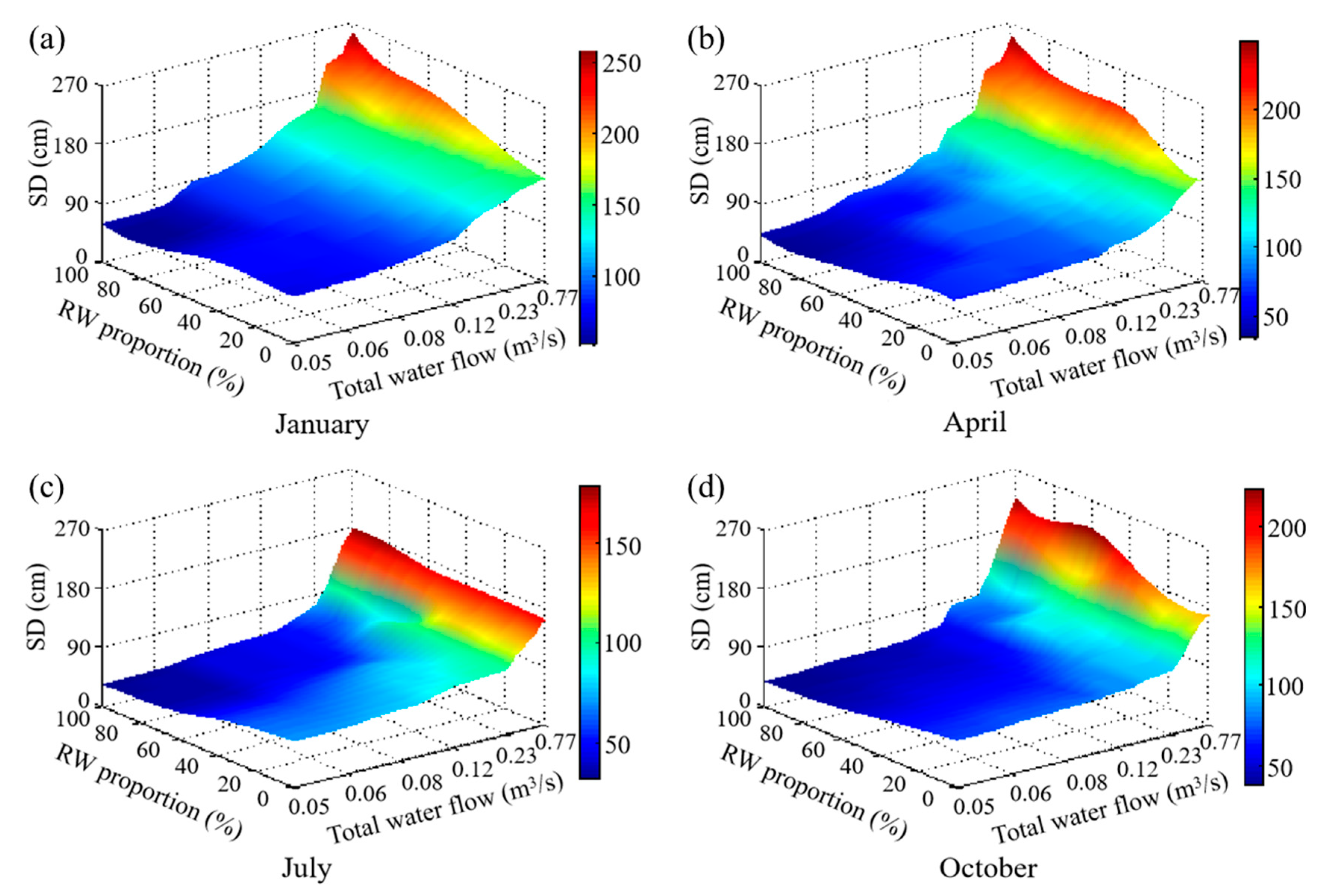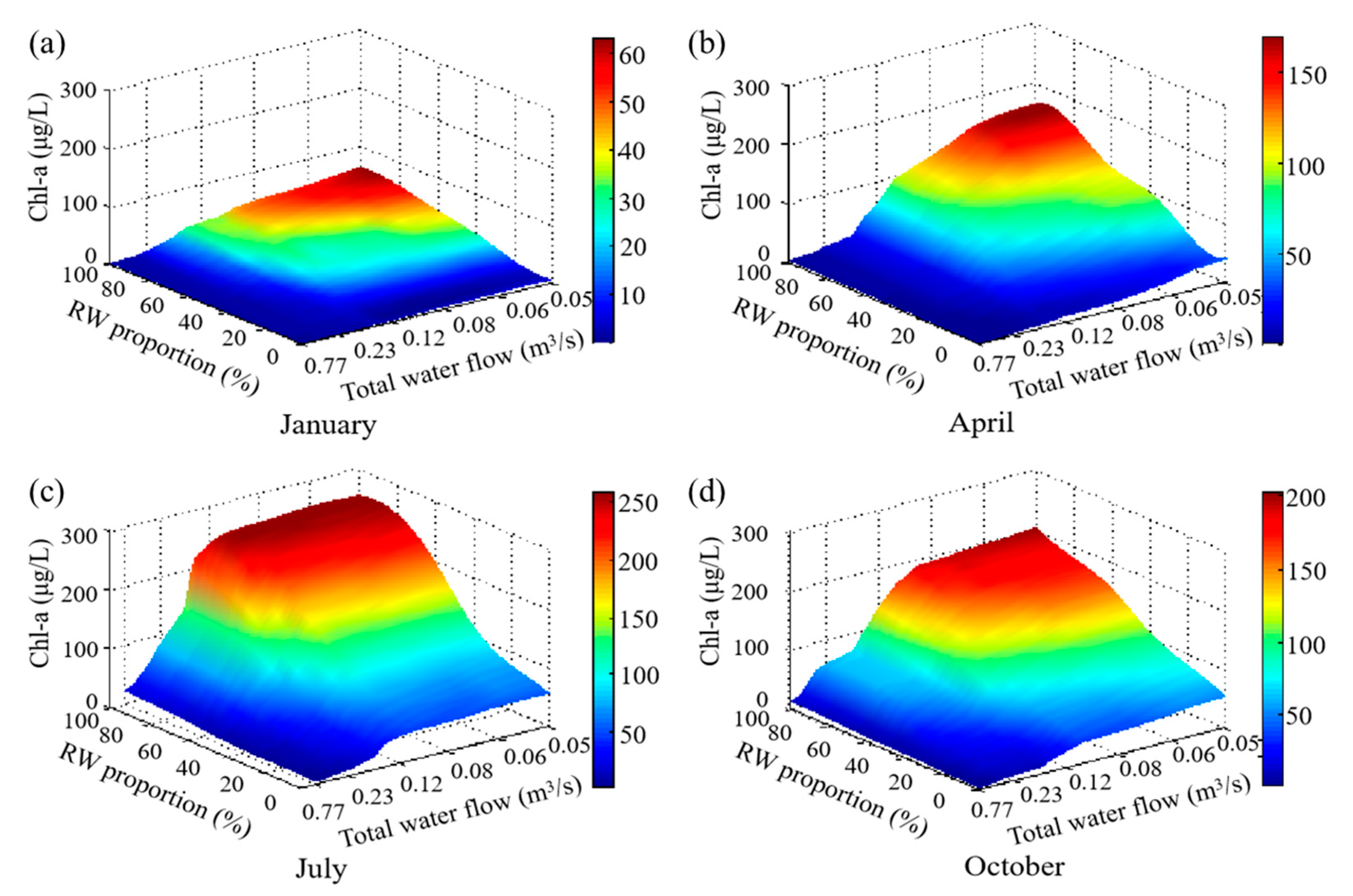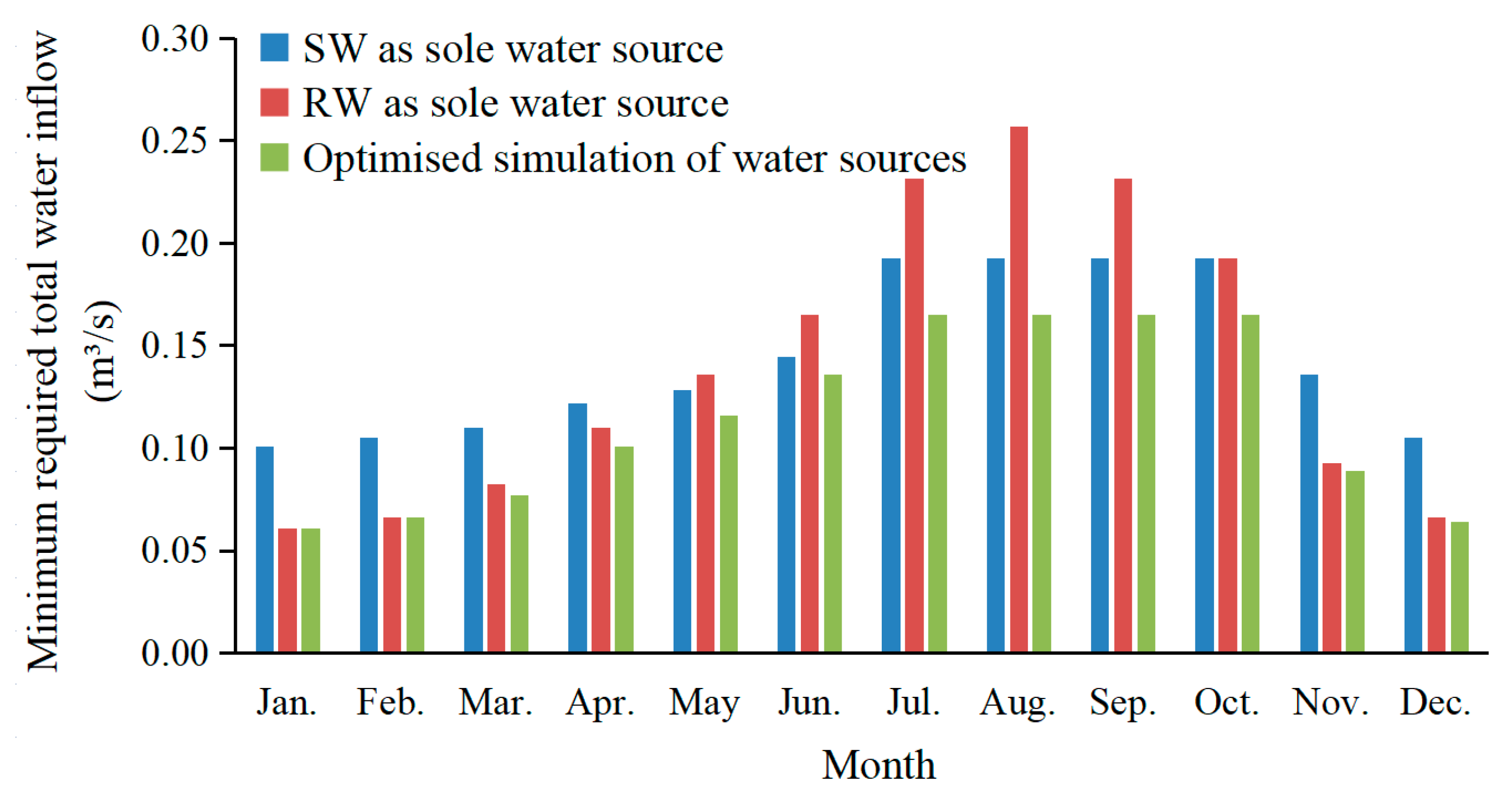Simulation Study on the Optimisation of Replenishment of Landscape Water with Reclaimed Water Based on Transparency
Abstract
:1. Introduction
2. Materials and Methods
2.1. Case Study Introduction and Water Quality Data Collection
2.1.1. Lake Introduction
2.1.2. Sampling and Water Quality Analysis
2.1.3. Lake Replenishment Water Quality
2.2. Method for Evaluating Water Transparency
2.3. Water Quality Modeling Process
2.3.1. Mesh Generation
2.3.2. Boundary Condition Setting
2.3.3. Model Calibration and Validation
3. Results and Discussion
3.1. Model Calibration and Validation
3.1.1. Hydrodynamic Model
3.1.2. Water Quality Model
3.2. Model Simulations
3.2.1. Changes in Water Quality under Various Replenishment Conditions
3.2.2. Water Replenishment Optimization
4. Conclusions
Author Contributions
Funding
Institutional Review Board Statement
Informed Consent Statement
Data Availability Statement
Acknowledgments
Conflicts of Interest
References
- Umer, A.; Assefa, B.; Fito, J. Spatial and seasonal variation of lake water quality: Beseka in the Rift Valley of Oromia region, Ethiopia. Int. J. Energy Water Resour. 2019, 4, 47–54. [Google Scholar] [CrossRef]
- Yang, S.Q. How to purify a polluted lake quickly–A case study from Shanghai, China. J. Water Resour. Prot. 2020, 12, 835–852. [Google Scholar] [CrossRef]
- Zheng, X.N.; Wu, D.X.; Huang, C.Q.; Wu, Q.Y.; Guan, Y.T. Impacts of hydraulic retention time and inflow water quality on algal growth in a shallow lake supplied with reclaimed water. Water Cycle 2022, 3, 71–78. [Google Scholar] [CrossRef]
- Zhu, Z.F.; Jie, D. Current status of reclaimed water in China: An overview. J. Water Reuse Desalination 2018, 8, 293–307. [Google Scholar] [CrossRef] [Green Version]
- Zhang, J.Z.; He, X.; Zhang, H.X.; Liao, Y.; Wang, Q.; Li, L.W.; Yu, J.W. Factors driving microbial community dynamics and potential health effects of bacterial pathogen on landscape lakes with reclaimed water replenishment in Beijing, PR China. Int. J. Environ. Res. Public Health 2022, 19, 5127. [Google Scholar] [CrossRef] [PubMed]
- Zhao, H.J.; Wang, Y.; Yang, L.L.; Yuan, L.W.; Peng, D.C. Relationship between phytoplankton and environmental factors in landscape water supplemented with reclaimed water. Ecol. Indic. 2015, 58, 113–121. [Google Scholar] [CrossRef]
- Chen, R.; Ao, D.; Ji, J.Y.; Wang, X.C.; Li, Y.Y.; Huang, Y.; Xue, T.; Guo, H.B.; Wang, N.; Zhang, L. Insight into the risk of replenishing urban landscape ponds with reclaimed wastewater. J. Hazard. Mater. 2016, 324, 573–582. [Google Scholar] [CrossRef]
- Ma, X.Y.; Li, Q.Y.; Wang, X.C.; Wang, Y.K.; Wang, D.H.; Ngo, H.H. Micropollutants removal and health risk reduction in a water reclamation and ecological reuse system. Water Res. 2018, 138, 272–281. [Google Scholar] [CrossRef]
- Chang, N.N.; Luo, L.; Wang, X.C.; Song, J.; Ao, D. A novel index for assessing the water quality of urban landscape lakes based on water transparency. Sci. Total Environ. 2020, 735, 139351. [Google Scholar] [CrossRef]
- Li, X.; Hao, L.N.; Li, G.J. Study on eutrophication in landscape lake of different trophic levels by microcosm experiment. Earth Environ. Sci. 2018, 199, 022062. [Google Scholar] [CrossRef]
- Liu, Y.; Ma, J.; Li, Y. Analysis of eutrophication of Yangtze river Yibin section. Energy Procedia 2012, 16, 203–210. [Google Scholar] [CrossRef] [Green Version]
- Chang, N.N. Study on the comprehensive index for water landscape effect assessing of urban water bodies. Ph.D. Thesis, Xi’an University of Architecture and Technology, Xi’an, China, 2020. [Google Scholar]
- Li, D.Q.; Huang, D.; Guo, C.F.; Guo, X.Y. Multivariate statistical analysis of temporal–spatial variations in water quality of a constructed wetland purification system in a typical park in Beijing, China. Environ. Monit. Assess. 2015, 187, 4219. [Google Scholar] [CrossRef] [PubMed]
- Nguyen, M.T.; Jasper, J.T.; Boehm, A.B.; Nelson, K.L. Sunlight inactivation of fecal indicator bacteria in open-water unit process treatment wetlands: Modeling endogenous and exogenous inactivation rates. Water Res. 2015, 83, 282–292. [Google Scholar] [CrossRef] [PubMed] [Green Version]
- Tripathi, M.; Singal, S.K. Use of principal component analysis for parameter selection for development of a novel water quality index: A case study of river Ganga India. Ecol. Indic. 2019, 96, 430–436. [Google Scholar] [CrossRef]
- Sommaruga, R.; Augustin, G. Seasonality in UV transparency of an alpine lake is associated to changes in phytoplankton biomass. Aquat. Sci. 2006, 68, 129–141. [Google Scholar] [CrossRef]
- Ao, D.; Luo, L.; Dzakpasu, M.; Chen, R.; Xue, T.; Wang, X.C. Replenishment of landscape water with reclaimed water: Optimization of supply scheme using transparency as an indicator. Ecol. Indic. 2018, 88, 503–511. [Google Scholar] [CrossRef]
- Sun, D.Y.; Li, Y.M.; Le, C.F.; Gong, S.Q.; Wang, H.J.; Wu, L.; Huang, C.C. Scattering characteristics of Taihu lake and its relationship models with suspended particle concentration. Environ. Sci. 2007, 28, 2688–2694. [Google Scholar] [CrossRef]
- Rimondi, V.; Monnanni, A.; De Beni, E.; Bicocchi, G.; Chelazzi, D.; Cincinelli, A.; Fratini, S.; Martellini, T.; Morelli, G.; Venturi, S.; et al. Occurrence and quantification of natural and microplastic items in urban streams: The case of Mugnone Creek (Florence, Italy). Toxics 2022, 10, 159. [Google Scholar] [CrossRef]
- Qin, H.P.; Khu, S.T.; Li, C. Water exchange effect on eutrophication in landscape water body supplemented by treated wastewater. Urban Water J. 2014, 11, 108–115. [Google Scholar] [CrossRef]
- Neill, G.B.; Anne, K.; Alwyn, T.; Rees, V.; Scherer, C.; Taylor, R.B.; Anja, W. Wave surge increases rates of growth and nutrient uptake in the green seaweed Ulvapertusa maintained at low bulk flow velocities. Aquat. Biol. 2008, 3, 179–186. [Google Scholar] [CrossRef] [Green Version]
- Zhang, P.; Su, Y.; Liang, S.K.; Li, K.Q.; Li, Y.B.; Wang, X.L. Assessment of long-term water quality variation affected by high-intensity land-based inputs and land reclamation in Jiaozhou Bay, China. Ecol. Indic. 2017, 75, 210–219. [Google Scholar] [CrossRef] [Green Version]
- Paliwal, R.; Patra, R.R. Applicability of MIKE 21 to assess temporal and spatial variation in water quality of an estuary under the impact of effluent from an industrial estate. Water Sci. Technol. 2011, 63, 1932–1943. [Google Scholar] [CrossRef]
- Ratheesh, K.R.; Purushothaman, C.S.; Sreekanth, G.B.; Manju, L.; Pandey, P.K. State of water quality of two tropical urban lakes located at Mumbai Megacity. Int. J. Sci. Res. 2015, 4, 1991–1998. [Google Scholar]
- Hu, S.L. Principal Component Analysis of Eutrophication and Nutrient Criteria in Xi’an Urban Landscape Waters. Master’s Thesis, Xi’an University of Architecture and Technology, Xi’an, China, 2016. [Google Scholar]
- Environmental Protection Agency of China. Standard Methods for the Examination of Water and Wastewater, 4th ed.; Chinese Environmental Science Press: Beijing, China, 2002. (In Chinese) [Google Scholar]
- State Environmental Protection Administration of China, General Administration of Quality Supervision, Inspection and Quarantine of the People’s Republic of China. Environmental Quality Standards for Surface Water (GB 3838-2002); Chinese Environmental Science Press: Beijing, China, 2002. (In Chinese) [Google Scholar]
- State Environmental Protection Administration of China, General Administration of Quality Supervision, Inspection and Quarantine of the People’s Republic of China. Water Quality of That Was Matched the Discharge Standard of Pollutants for Municipal Wastewater Treatment Plant (GB 18918-2002); Chinese Environmental Science Press: Beijing, China, 2002. (In Chinese) [Google Scholar]
- Tyler, J.E. The secchi disc. Limnol. Oceanogr. 1968, 13, 1–6. [Google Scholar] [CrossRef]
- Losada, J.P. A Deterministic Model for Lake Clarify; Application to Management of Lake Tahoe (California–Nevada), USA. Ph.D. Thesis, University of Girona, Girona, Spain, 2001. [Google Scholar]
- Håkanson, L.; Boulion, V.V. A Model to Predict How Individual Factors Influence Secchi Depth Variations among and within Lakes. Int. Rev. Hydrobiol. 2003, 88, 212–232. [Google Scholar] [CrossRef]
- Liu, J.; Sun, D.Y.; Zhang, Y.L.; Li, Y.M. Pre-classification improves relationships between water clarity, light attenuation, and suspended particulates in turbid inland waters. Hydrobiologia 2013, 711, 71–86. [Google Scholar] [CrossRef]
- Larson, G.L.; Hoffman, R.L.; Hargreaves, B.R.; Collier, R.W. Predicting Secchi disk depth from average beam attenuation in a deep, ultra-clear lake. Hydrobiologia 2007, 574, 141–148. [Google Scholar] [CrossRef]
- Kirk, J. Light and Photosynthesis in Aquatic Ecosystems; Cambridge University Press: Cambridge, UK, 1994. [Google Scholar]
- Danish Hydraulic Institute (DHI). MIKE 3 Flow Model FM: Eutrophication Model 2 EcoLab Template—Scitific Description. DHI–Water; Environment and Health: Hørsholm, Denmark, 2013. [Google Scholar]
- Wu, S. Analysis of rainfall characteristics and experimental study of runoff-producing and flow concentration characteristics of city’s underlying surface in Xi’an. Master’s Thesis, Xi’an University of Technology, Xi’an, China, 2004. [Google Scholar]
- Yun, Z.L. Study on the characteristics of atmospheric dust pollution of Xi’an city. Master’s Thesis, Chang’an University, Chang’an, China, 2013. [Google Scholar]
- Guo, W.J. Research on urban rainfall-runoff pollution characteristics and load stimation in Xi’an. Master’s Thesis, Xi’an University of Technology, Xi’an, China, 2015. [Google Scholar]
- Swift, T.J.; Perez-Losada, J.; Schladow, S.G.; Reuter, J.E.; Jassby, A.D.; Goldman, C.R. Water clarity modeling in Lake Tahoe: Linking suspended matter characteristics to Secchi depth. Aquat. Sci. 2006, 68, 1–15. [Google Scholar] [CrossRef]
- Ge, J.W.; Wu, S.Y.; Touré, D.; Cheng, L.M.; Miao, W.J.; Cao, H.F.; Pan, X.Y.; Li, J.F.; Yao, M.M.; Feng, L. Analysis on biomass and productivity of epilithic algae and their relations to environmental factors in the Gufu River basin, Three Gorges Reservoir area, China. Environ. Sci. Pollut. Res. Int. 2015, 24, 26881–26892. [Google Scholar] [CrossRef]






| NH4+-N | NO3−-N | IP | SS | |
|---|---|---|---|---|
| SW(mg/L) | 1.65 | 0.35 | 0.2 | 60 |
| RW(mg/L) | 5 | 10 | 0.5 | 10 |
| Month | Water Quality of Influent (mg/L) | Dry Deposition (kg/Month) | |||||
|---|---|---|---|---|---|---|---|
| NH4+-N | NO3−-N | IP | SS | NH4+-N | NO3−-N | IP | |
| January | 0.97 | 2.89 | 0.021 | 12.62 | 22.7 | 15.6 | 3.0 |
| February | 0.80 | 2.95 | 0.027 | 7.93 | 20.5 | 14.1 | 2.7 |
| March | 0.88 | 2.86 | 0.018 | 12.69 | 22.2 | 14.1 | 2.8 |
| April | 0.83 | 2.51 | 0.012 | 13.72 | 20.4 | 13.0 | 2.5 |
| May | 0.39 | 1.66 | 0.013 | 16.61 | 22.1 | 14.0 | 2.7 |
| June | 0.76 | 0.50 | 0.041 | 11.22 | 12.6 | 5.0 | 1.8 |
| July | 0.32 | 0.53 | 0.016 | 14.31 | 13.3 | 5.2 | 1.9 |
| August | 0.68 | 0.87 | 0.014 | 12.23 | 13.5 | 5.3 | 1.9 |
| September | 0.22 | 0.66 | 0.012 | 13.18 | 3.8 | 1.6 | 0.9 |
| October | 0.58 | 0.97 | 0.010 | 15.17 | 5.7 | 2.4 | 1.3 |
| November | 1.66 | 0.78 | 0.012 | 9.92 | 9.4 | 3.9 | 2.1 |
| December | 1.69 | 2.06 | 0.045 | 11.12 | 25.4 | 17.4 | 3.3 |
| No. | Parameter | Description (Unit) | Value |
|---|---|---|---|
| Hydrodynamic parameters | |||
| 1 | Resistance | 0.035 | |
| 2 | Smagorinsky coefficient | 0.28 | |
| 3 | Light refraction index | 0.3 | |
| Water transparency parameters | |||
| 1 | γ | Eye’s ability to distinguish contrast | 8.9 |
| 2 | The absorption by pure water (1/m) | 0.050 | |
| 3 | The chlorophyll-specific absorption coefficient (m2/mg chl-a) | 0.020 | |
| 4 | The absorption coefficient by inorganic suspended solids (ISS) (m2/g ISS) | 0.08 | |
| 5 | The absorption coefficient by detritus carbon (m2/g DC) | 0.24 | |
| 6 | The scattering by pure water (1/m) | 0.0019 | |
| 7 | The scattering coefficient by ISS (m2/g ISS) | 0.025 | |
| Water quality parameters | |||
| 1 | mypc | Growth rate phytoplankton C (per day) | 2.8 |
| 2 | deac | 1st order death rate for phytoplankton(per day) | 0.10 |
| 3 | tetg | Temperature dependency growth ratefor phytoplankton | 1.14 |
| 4 | Kn | Half-saturation constant for nitrogen uptake(mg N/L) | 0.05 |
| 5 | Kp | Half-saturation concentration forphosphorus uptake(mg P/L) | 0.009 |
| 6 | kmdm | Detritus C mineralization rate (per day) | 0.040 |
Disclaimer/Publisher’s Note: The statements, opinions and data contained in all publications are solely those of the individual author(s) and contributor(s) and not of MDPI and/or the editor(s). MDPI and/or the editor(s) disclaim responsibility for any injury to people or property resulting from any ideas, methods, instructions or products referred to in the content. |
© 2023 by the authors. Licensee MDPI, Basel, Switzerland. This article is an open access article distributed under the terms and conditions of the Creative Commons Attribution (CC BY) license (https://creativecommons.org/licenses/by/4.0/).
Share and Cite
Ao, D.; Wei, L.; Pei, L.; Liu, C.; Wang, L. Simulation Study on the Optimisation of Replenishment of Landscape Water with Reclaimed Water Based on Transparency. Int. J. Environ. Res. Public Health 2023, 20, 4141. https://doi.org/10.3390/ijerph20054141
Ao D, Wei L, Pei L, Liu C, Wang L. Simulation Study on the Optimisation of Replenishment of Landscape Water with Reclaimed Water Based on Transparency. International Journal of Environmental Research and Public Health. 2023; 20(5):4141. https://doi.org/10.3390/ijerph20054141
Chicago/Turabian StyleAo, Dong, Lijie Wei, Liang Pei, Chengguo Liu, and Liming Wang. 2023. "Simulation Study on the Optimisation of Replenishment of Landscape Water with Reclaimed Water Based on Transparency" International Journal of Environmental Research and Public Health 20, no. 5: 4141. https://doi.org/10.3390/ijerph20054141
APA StyleAo, D., Wei, L., Pei, L., Liu, C., & Wang, L. (2023). Simulation Study on the Optimisation of Replenishment of Landscape Water with Reclaimed Water Based on Transparency. International Journal of Environmental Research and Public Health, 20(5), 4141. https://doi.org/10.3390/ijerph20054141







